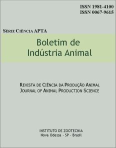Influence of male-to-female ratio and climatic conditions on the reproductive performance of Anglo Nubian goats
DOI:
https://doi.org/10.17523/bia.v71n3p284Palavras-chave:
biostimulation, goats, male effectResumo
The objective of this study was to test the €œmale effect€ on the reproductive performance of Anglo Nubian does (n = 180), aged between 24 and 60 months, under different male-to-female ratios (1:20 €“ T20, 1:30 €“ T30, and 1:40 €“ T40) and climatic conditions (dry season €“ DS, and rainy season €“ RS). Does were randomly distributed into three groups (T20, T30, and T40) and were isolated from bucks at a distance of 300 m for 60 days before the start of the experiments. The first manifestation of estrous during the DS occurred 6.83 ± 4.54 (T20), 6.72 ± 4.56 (T30) and 7.05 ± 5.23 (T40) days following the onset of the breeding season (P>0.05). In the RS, onset of estrous was observed 6.60 ± 4.74 (T20), 6.70 ± 4.43 (T30) and 7.46 ± 4.54 (T40) days after the beginning of the breeding season (P>0.05). Estrous induction in females during the DS occurred in 95% (T20), 80% (T30), and 75.5% (T40) of all females. During the RS, estrous detection reached 100% (T20), 100% (T30), and 97.5% (T40) of all females, with no difference between all RS and DS groups. Estrous synchronization during the DS occurred in 35.00% (T20), 36.66% (T30), and 32.50% (T40) of all females, for an average occurrence of 34.72%. During the RS, synchronization occurred in 65% (T20), 70% (T30) and 62.25% (T40) of all females, for an average occurrence of 65.75%; no difference was detected between the RS and the DS. Pregnancy rates in the DS groups were 65.0% (T20), 70.0% (T30), and 62.5% (T40), while pregnancy rates in the RS were 90.0% (T20), 86.6% (T30), and 95.0% (T40). No difference was observed for conception rates between any of the RS and DS groups. Prolificacy during the DS was 1.30 (T20), 1.30 (T30) and 1.35 (T40), while in the RS prolificacy was 1.29 (T20), 1.25 (T30) and 1.30 (T40). Thus, the male effect can be used effectively for goats under 1:20€“1:40 male-to-female ratios in a 45-day mating season under varying climatic conditions.Downloads
Downloads
Publicado
Edição
Seção
Licença
Os autores não serão remunerados pela publicação de trabalhos, pois devem abrir mão de seus direitos autorais em favor deste periódico. Por outro lado, os autores ficam autorizados a publicar seus artigos, simultaneamente, em repositórios da instituição de sua origem, desde que citada a fonte da publicação original seja Boletim de Indústria Animal. A revista se reserva o direito de efetuar, nos originais, alterações de ordem normativa, ortográfica e gramatical, com vistas a manter o padrão culto da língua e a credibilidade do veículo. Respeitará, no entanto, o estilo de escrever dos autores. Alterações, correções ou sugestões de ordem conceitual serão encaminhadas aos autores, quando necessário. Nesses casos, os artigos, depois de adequados, deverão ser submetidos a nova apreciação. As opiniões emitidas pelos autores dos artigos são de sua exclusiva responsabilidade. Todo o conteúdo deste periódico, exceto onde está identificado, está licenciado sob a Licença Creative Commons Attribution (CC-BY-NC). A condição BY implica que os licenciados podem copiar, distribuir, exibir e executar a obra e fazer trabalhos derivados com base em que só se dão o autor ou licenciante os créditos na forma especificada por estes. A cláusula NC significa que os licenciados podem copiar, distribuir, exibir e executar a obra e fazer trabalhos derivados com base apenas para fins não comerciais.













